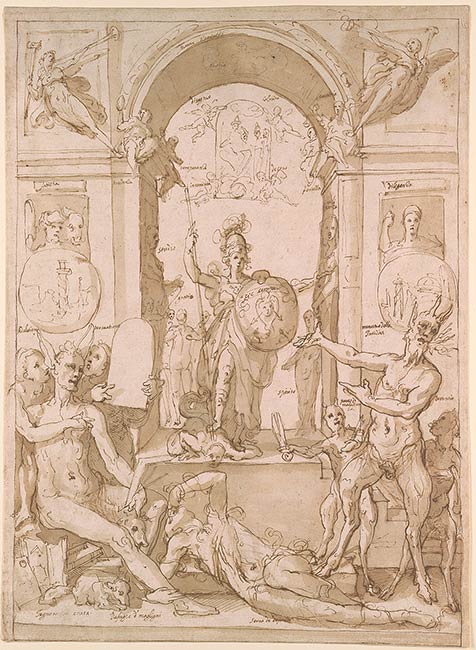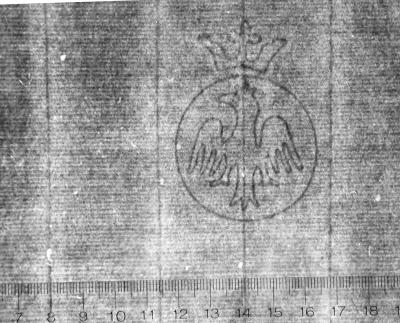
The drawing is one of three studies related to the Porta Virtutis scandal that caused Federico Zuccaro to be expelled from Rome in November 1581 on the orders of Pope Gregory XIII Boncompagni.1 The artist had painted a wall hanging, often referred to as a large cartoon, depicting Minerva beneath a triumphal arch guarding the realm of artistic virtue from Crass Ignorance and Envy. The cartoon had been prominently displayed on the facade of the church of San Luca in Rome on 18 October 1581, the feast day of St. Luke, when painters traditionally gathered once a year for a religious celebration. The image was interpreted—and was likely originally intended—as a satire on the ignorance of Federico’s former patron Paolo Ghiselli (who had rejected Federico’s altarpiece commissioned for his chapel in Bologna) and the circle of Bolognese artists who had advised Ghiselli. In the wake of the Council of Trent and the precepts on art that it promulgated, the Bolognese altarpiece, which featured large nudes in the foreground, was probably considered unseemly. Nevertheless, the criticism from the Bolognese coterie of artists may have been motivated by their desire to keep foreign artists out of their city rather than by the actual appearance of the painting.
Whereas a drawing in the Christ Church Picture Gallery, Oxford, probably served as the modello for the 1581 cartoon, the Morgan and Frankfurt versions of the composition were most likely created by Federico in his own defense during his trial or after his expulsion from Rome. In the Oxford drawing, for instance, Federico’s disputed painting, the Procession and Vision of St. Gregory, may be seen in the distance beyond the triumphal arch being carried heavenward, whereas the Morgan and Frankfurt compositions depict in its place a painting of an enthroned ruler with scepter and attendants. Furthermore, at his trial, Federico emphasized that the Porta Virtutis was to be interpreted in a general fashion and not seen as a specific reference to Ghiselli and the imbroglio. This argument was probably an attempt by Federico to mitigate the scandal and to disassociate the Porta Virtutis from the Bolognese affair. During his trial, Federico wrote to his patrons in Florence and Urbino to solicit their support, and the Morgan sheet may have been created to accompany such a letter.2
Federico had already developed a similar allegorical subject in an earlier drawing, the Garden of the Liberal and Fine Arts, also in the Morgan’s collection (see 1983.67), in which a triumphal arch of virtue leading to the temples of honor and fame appears in the background.3
—REP
Footnotes:
- The other two studies are at Christ Church Picture Gallery, Oxford, inv. 0213, and Städel Museum, Frankfurt, inv. 1319.
- Heikamp 1957, 191 and note 46.
- The Morgan Library & Museum, New York, inv. 1983.67. See Milwaukee and New York 1989–90, no. 78.
* This entry was first published in From Raphael to Carracci: The Art of Papal Rome, National Gallery of Canada, 2009. The author is grateful to Laura Z. Stone for her assistance in research- ing this drawing.
Inscribed throughout by the artist, mostly with the names of allegorical personages, porta vertutis; gloria; disegnio / colorito / inventione; decoro; prudenza; temperanza; giustitia; fortezza; faticha; diligenza; studio, intiligenza; gratie; spirirto; Adulatione; persuatione; ministro della Invidia; parto di maladicenza; destratio; prospetiva; pitura; Ignorantia crasa; Refugio dei magligni; serva da dapochi.
Watermark: Eagle in a circle surmounted by a crown (Briquet 209; Verona, 1582-96).
Colville, Norman, Captain, former owner.
Scholz, János, former owner.
Rhoda Eitel-Porter and and John Marciari, Italian Renaissance Drawings at the Morgan Library & Museum, New York, 2019, no. 122.
Selected references: Indianapolis 1954, no. 39; Heikamp 1957, 189-94; Heikamp 1958, 46; London 1960, under no. 80; Cologne 1963-64, no. 178; New Haven 1964, no. 54; New York 1965-66, no. 141; London and elsewhere 1968, no. 115; Middletown 1969, no. 14; Washington and New York 1973-74, no. 10; Byam Shaw 1976, under no. 544; Cavazzini 1989, 169-77; Milwaukee and New York 1989-90, no. 85; Acidini Luchinat 1998-99, 2:129, 149n53; Ottawa 2009, no. 111.
Detlef Heikamp, "Ancora su Federico Zuccari," Rivista d'Arte, 33, 1958, p. 46, n. 7.
Jacob Bean and Felice Stampfle, Drawings from New York Collections, I, The Italian Renaissance, exh. cat., Metropolitan Museum of Art, New York 1965-1966, no. 141, repr.
Konrad Oberhuber and Dean Walker, Sixteenth Century Italian Drawings From the Collection of János Scholz, exh. cat., National Gallery of Art, Washington, D.C., and The Pierpont Morgan Library, New York, 1973-1974, no. 10.
Patrizia Cavazzini, "The Porta Virtutis and Federico Zuccari's Expulsion from the Papal State. An Unjust Conviction," Römisches Jahrbuch der Biblioteca Hertziana, XXV, 1989, pp. 169-177, repr. fig. 3.
E. James Mundy, Renaissance into Baroque: Italian Master Drawings by the Zuccari 1550-1600, exh. cat., Milwaukee Art Museum, Milwaukee, and National Academy of Design, New York, 1989-90, pp. 252-255, no. 85, repr.
Cristina Acidini Luchinat, Pintoricchio, Florence, 1999, II, pp. 129, 149 note 53, repr. fig. 18.
David Franklin, ed., From Raphael to the Carracci: The Art of Papal Rome, exh. cat., National Gallery of Canada, Ottawa, 2009, pp. 348-49, no. 111, repr.

